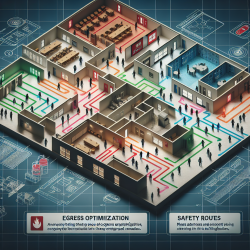Introduction
In critical scenarios like active shooter events, making the right decisions during evacuation can mean the difference between life and death. Recent research has demonstrated the effectiveness of a non-homogeneous semi-Markov-Decision-Process (NHSMDP) based naive algorithm that optimizes egress paths by utilizing real-time updates on a shooter's location. This approach can significantly enhance safety outcomes by reducing casualties by 56% and minimizing time spent in the shooter's line of sight by 52% compared to traditional evacuation strategies.
Understanding the NHSMDP Approach
The NHSMDP algorithm relies on prior knowledge of a building's layout and continuously updates the shooter's location using a camera network. This allows for an optimized egress plan that incorporates the option for evacuees to wait for danger to pass before proceeding. This ability to include sojourn times in the evacuation strategy is a notable augmentation to current methods.
Traditional evacuation strategies often focus on the fastest route to safety, which may not always be the safest. The NHSMDP approach, however, considers the dynamic nature of active shooter scenarios, where threats are localized and mobile. This method enables evacuees to make informed decisions, such as when to hide or run, based on the shooter's movements.
Practical Implications for Practitioners
For practitioners working in schools or workplaces, implementing this algorithm can greatly improve safety outcomes during active shooter events. By integrating a camera-based shooter-identification and tracking system, schools can provide real-time updates to evacuees, guiding them along the safest egress paths. The algorithm's ability to dynamically adjust routes based on the shooter's location ensures that evacuees are directed away from danger.
Furthermore, the NHSMDP approach can be tailored to specific building layouts and populations, taking into account factors such as evacuee speed and distribution. This flexibility allows for a customized evacuation strategy that maximizes safety for all individuals involved.
Encouraging Further Research
While the NHSMDP algorithm shows promising results, further research is needed to refine and enhance its effectiveness. Practitioners are encouraged to explore additional factors that may impact evacuation outcomes, such as human behavior and decision-making under stress. By incorporating these elements into the algorithm, we can develop even more robust evacuation strategies.
Additionally, exploring the ethical considerations of prioritizing certain groups during evacuation can help ensure that the algorithm is equitable and just. Engaging with experts in psychology, education, and emergency planning can provide valuable insights into these complex issues.
Conclusion
The NHSMDP-based naive algorithm represents a significant advancement in optimizing egress paths during active shooter scenarios. By leveraging real-time data and incorporating strategic waiting times, this approach can greatly enhance safety outcomes for evacuees. Practitioners are encouraged to implement this algorithm in their emergency planning efforts and to continue exploring ways to improve evacuation strategies.
To read the original research paper, please follow this link: The effectiveness of naive optimization of the egress path for an active-shooter scenario.










